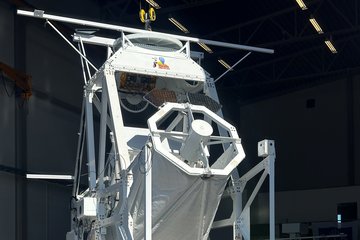All genres
441.
Poster
Oxygen isotope fractionation in equilibrated high-temperature feldspar-rich rocks. GeoBonn 2018, Bonn, Germany (2019)
442.
Poster
Surface properties of comet 67P/Churyumov-Gerasimenko from MIRO and VIRTIS. Asia Oceania Geosciences Society (AOGS) 15th Annual Meeting, Honolulu, Hawaii (2018)
443.
Poster
The inner coma of comet 67P/Churyumov-Gerasimenko. Rocks \& Stars II, Göttingen, Germany (2017)
444.
Poster
Hydrological cycle in the general circulation model of the Martian atmosphere. Sixth international workshop on the Mars atmosphere: Modelling and observations , Granada, Spain (2017)
445.
Poster
JUICE: A European Mission to Jupiter and its Icy Moons. DPS 48/EPSC 11, Pasadena, USA (2016)
446.
Poster
Tracing the Composition of Hydrogen Cyanide in the Stratosphere of Titan from Space, Airborne, and Ground-Based Observations. ESA SCI Science Workshop #9, Aklersloot, Netherlands (2016)
447.
Poster
The Submillimetre Wave Instrument on JUICE. Ground and space observatories: a joint venture to planetary science, Santiago, Chile (2015)
448.
Poster
Results of the HssO Key Programme with the Herschel Space Observatory. Ground and space observatories: a joint venture to planetary science, Santiago, Chile (2015)
449.
Poster
Results of the HssO Key Programme with the Herschel Space Observatory. ALMA/Herschel Archival Workshop, Garching, Germany (2015)
450.
Poster
Some Results of the HssO Key Programme with the Herschel Space Observatory. ESA SRE Science Workshop, Aranjuez, Spain (2015)
451.
Poster
The origin of CO in the atmosphere of Uranus. 11th Annual Meeting, Asia Oceania Geosciences Society, Sapporo, Japan (2014)
452.
Poster
Venusian Mesospheric thermal structure and winds from May 2009 SMT CO spectral- line observations. 40th COSPAR Scientific Assembly, Moscow, Russia (2014)
453.
Poster
New Determination of the HCN Profile in the Stratosphere of Neptune from Millimeter-wave Spectroscopy. Asia Oceania Geosciences Society (AOGS) 11th Annual Meeting, Sapporo, Japan (2014)
454.
Thesis - PhD
Chirptransformations-Spektrometer für die passive Millimeterwellenradiometrie: Messungen der 142 GHz Emissionslinie des atmosphärischen Ozons. Dissertation, Georg-August-Universität Göttingen (1989)
455.
Thesis - Diploma
Raumflugtauglicher FM-Pulskompressionsempfänger mit Oberflächenwellenfiltern für die Millimeter- und Submillimeterwellenspektroskopie. Diploma, Georg-August-Universität Göttingen (1985)
456.
Working Paper
Planetary Science with Astrophysical Assets: Defining the Core Capabilities of Platforms. Astro2020 Science White Paper (2019), 7 pp.
457.
Report
The European Far-Infrared Space Roadmap. Diverse (2017)
458.
Report
Comet C/2011 L4 (Panstarrs). Central Bureau Electronic Telegrams 3230, 1 (2012)
459.
Report
Hydrodynamic model of the Martian atmosphere between near-surface layers and an altitude of about 130 km. Max-Planck-Institut für Aeronomie, Katlenburg-Lindau, Germany (2002)
460.
Report
Microwave Investigation of the Martian Atmosphere and Surface. JPL, California Institute of Technology, Pasadena, CA, USA (2000)











